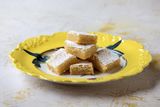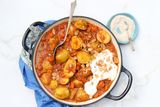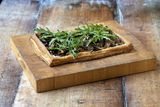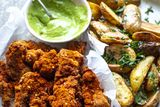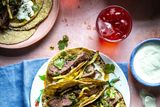A taste of China from Jeremy Pang
Get ready to celebrate Chinese New Year with traditional favourites like dumplings and fish from recipes from Jeremy Pang's exciting new book. It's packed with lots of advice, including his 'wok clock' concept to get you cooking like a pro
When thinking of Hong Kong, most people picture a big, busy, skyscraper-filled city, but I immediately imagine (and can even almost taste) a giant bowl of chilli and garlic clams, enjoyed while sitting next to the seafront of Sai Kung harbour. Dotted with fishing boats, Sai Kung is nothing but lowrise houses, beaches and restaurants full of fresh seafood - quite the contrast to modern Hong Kong. The Chinese like to think that clams look like old gold bullions, and therefore represent good wealth, which is why this dish is eaten a lot during Chinese New Year.
Chilli and garlic 'wealthy' clams
Serves: 2-4 with side dishes
Preparation time: 15 minutes
Cooking time: 5 minutes
YOU WILL NEED
500g fresh clams
2 garlic cloves
A thumb-size piece of ginger
2 fresh red chillies
A small handful of fresh coriander sprigs
1 tbsp vegetable oil
The Sauce 1 tsp chilli bean sauce
4 tbsp Shaoxing rice wine
4 tbsp water
1 tbsp light soy sauce
½ tsp dark soy sauce
Method
Sort through the clams, discarding any that don't close when tapped gently.
Wash the clams thoroughly by running them under cold water and rinsing them 3 or 4 times, then place the clams in a mixing bowl.
Finely chop the garlic, ginger and chillies. Mix the sauce ingredients together in a small bowl or ramekin.
BUILD YOUR WOK CLOCK:
Place your chopped garlic at 12 o'clock, then arrange the ginger, chillies, clams, sauce bowl and coriander clockwise around your plate.
Heat the oil in a wok over a medium heat, then add the garlic, chilli and ginger and stir-fry for 20-30 seconds until fragrant.
Increase the heat to high and add the clams to the wok, then immediately pour over the sauce and bring to a vigorous boil. Cover with a lid and cook for 3-5 minutes, shaking occasionally, until the clams have opened up. Some clams may still remain closed after cooking - discard any that haven't opened after this time.
Tip the clams into a large bowl, stir in the coriander sprigs and serve.
SWAPSIES:
Chilli bean sauce is made mainly of minced fermented broad beans, chilli and garlic. If you cannot find it, blend together 3 fresh large red chillies, 2 garlic cloves, and 1 tablespoon of tinned butter beans along with 1 tablespoon of the brine solution from the butter beans for a close substitution.
Tip
As with all seafood, the most important tip here is not to overcook the clams - remember to control the heat of your wok by shaking it when needed, so as to cook them just through, but no more.
Shiitake and chive dumplings
Dumplings
Most Chinese dumplings can either be deep-fried, pan-fried, steamed or blanched, though there is something incredibly moreish about deep-fried ones with their crunchy exterior and hot, steamy filling.
Much like fresh pasta, when made from scratch, dumplings should not be overcooked - whichever way you choose to cook them, the cooking process itself should not take any longer than 5 minutes. The goal is to cook the pastry and filling through, while keeping that 'al dente' bite. Served with noodles, these make a great alternative to a Sunday lunch.
Serves: 6 (makes 20-25 dumplings)
Preparation time: 1 hour
Cooking time: 10 minutes
You will need
225g plain flour
130-150ml hot water
Vegetable oil, for frying
The Filling
50g rice vermicelli noodles
A handful of coriander
1 spring onion
A thumb-size piece of ginger
1 garlic clove
5 shiitake mushrooms, soaked and drained (see tip)
200g Chinese chives or garlic shoots
5 pak choi leaves
1 leaf of Chinese leaf cabbage
The Marinade
1 tbsp light soy sauce
¼ tsp black pepper
¼ tsp granulated sugar
2 tsp sesame oil
½ tbsp cornflour
The Dipping Sauce 4 tbsp light soy sauce
4 tbsp Chinkiang black rice vinegar
a thumb-size piece of ginger, finely sliced
Method
Sieve the flour into a bowl. Gradually add the water, mixing with a fork to form a dough, then knead it on a lightly dusted surface for 5 minutes until slightly elastic.
Roll out the pastry to a thickness of 1-2mm, then use a 70mm diameter circular cutter to cut out as many pastries as possible. Set the pastries aside on a baking sheet or tray and cover with a tea towel until needed.
For the filling, put the noodles in a bowl, cover with hot water and soak for 3 minutes. Drain and dry the noodles on a clean kitchen towel, then finely chop them along with all the other filling ingredients. Put the chopped filling ingredients in a bowl along with the marinade ingredients and mix together well.
Combine the dipping sauce ingredients in a small bowl or ramekin and wrap the dumplings as shown below.
WRAPPING
1. Place 1 teaspoon of the filling in the centre of each circle of dough. Fold the bottom centre over the filling to form a semicircle and pinch the top tight.
2. Pinch the two corners of the semicircle together leaving two symmetrical 'Mickey Mouse ear' shapes between your centre fold and the corner folds.
3. Now pinch the 'ears' in towards you to make four layered folds.
4. Tidy up to create a 'half-moon' shape and arrange on a plate.
COOKING
Half-fill a large pot, wok or deep-fryer with vegetable oil and heat to 180°C (350°F), or until the tip of a wooden chopstick or skewer starts to fizz after a second or so in the oil.
Carefully add the dumplings in batches of no more than 10 and deep-fry for 3 minutes, until golden brown. Remove the dumplings carefully with a slotted spoon and drain well on a plate covered with kitchen paper. Serve immediately with the dipping sauce.
Tip
To rehydrate dried mushrooms, cover them in 300ml hot water and leave to soak for at least 1 hour (preferably overnight). Drain them before using, reserving the soaking water for use in your recipe, if necessary.
Sea Bass with crushed Soybeans and Chilli Sauce
Sea Bass with crushed Soybeans and Chilli Sauce
Much like a portrait painter, sometimes I am 'commissioned' to create a recipe that matches a dish that a student has once eaten. When this happens there is always the challenge of creating something that lives up to expectations - when successful, however, the reward is well worth it.
This recipe started out as one of my commissioned pieces. Over the years, I have adapted it slightly, making it more about the fish itself than fulfilling a specific brief. It's delicious and works perfectly served with simple blanched greens on the side.
You will need
1 tbsp salted soybeans
2 garlic cloves
1 bird's-eye chilli
A large handful of coriander
1 x 350-500g sea bass, scaled, gutted and de-gilled (ask your fishmonger to do this for you)
1 tbsp vegetable oil
The Sauce 1 tsp chilli bean sauce
1 tbsp hoisin sauce
1 tbsp Shaoxing rice wine
100ml chicken or vegetable stock, or hot water
A dash of dark soy sauce
Method
Lightly crush the soybeans in a small bowl with the back of a teaspoon. Finely chop the garlic and chilli. Roughly chop the coriander.
Wash the fish, pat dry and place on a large plate or platter suitable for steaming. Mix the sauce ingredients together in a small bowl.
BUILD YOUR WOK CLOCK:
Place the crushed soybeans at 12 o'clock, then arrange the garlic, chilli, sauce bowl and chopped coriander clockwise around the plate.
Set a large wok or steaming pan up with a steamer stand and fill with boiling water to a third of the way up the sides. Place the fish plate into the wok or pan, cover with a lid and steam for 7-12 minutes, until cooked (see tip). Remove and set aside, covering the fish with foil so it stays warm and moist.
Drain and dry the wok, add the vegetable oil and heat until smoking. Add the soybeans and stir-fry for 30 seconds, then add the garlic, chillies and sauce. Bring to a vigorous boil, then add half the coriander and continue to cook for 1 minute until the sauce has thickened and reduced by at least a third.
Pour the sauce over the steamed fish and garnish with the remaining coriander to serve.
SWAPSIES: Salted soybeans are fermented soybeans preserved in brine and can be found in most Chinese supermarkets. They add a nice texture to this sauce, however, if you cannot find them, the dish works just as well without.
Tip
To check whether your fish is fully cooked, pull the dorsal fin (the one on the back) lightly. If it falls off without any force, the fish will be cooked through to the bone. Remove from the pan and set aside.
THE WOK CLOCK
Wok clock
I often get asked how Chinese takeaways manage to serve up a number of dishes so quickly. Aside from the amazingly powerful equipment they have access to in their commercial kitchens, there are also some basic organising techniques they use which are invaluable when it comes to keeping your cooking quick as well as your kitchen clean and tidy. One specific technique, which we call 'The Wok Clock' and have developed and use daily at the School of Wok, will help you to take that leap forward by setting up your ingredients in order of use before you start to cook. By doing this, you won't even have to look back at the recipe while in the throes of cooking, saving yourself time and energy without ever having to sacrifice the cooking of your ingredients while you reread your recipe.
Once you have prepared all your ingredients, place them in their cooking order on a large round plate, beginning at 12 o'clock and working your way clockwise all around. It's that simple! This organisation is not exclusive to wok cooking (the 'wok clock' is just a simple phrase to remember); whether you are cooking a stir-fry or a slow-cooked curry, it works. The photo above, for example, demonstrates a wok clock set up for our School of Wok Stir-fried Sichuan Chicken. Once you get in the habit of organising your ingredients in this way, you'll find cooking as a whole to be a much neater and more straightforward process, freeing you up to experience the joys of preparing dishes and learning new techniques rather than constantly scampering to consult your recipe books.
BALANCE IN CHINESE FOOD
Chinese food is all about achieving a balance of flavour, texture and colour - whether you are serving one plate or several plates of food. While there are certain individual dishes that can touch almost all your flavour sensations at the same time, to master the true skill of Chinese cooking, the more challenging scenario is being able to select a number of dishes which touch all or most of the basic tastes (sweet, sour, salty, savoury/umami, spicy and bitter), a good combination of textures (crispy, soft, melt-in-the-mouth or succulent) and are in turns meaty and rich, light and fresh.
If your meal covers all of the above, you are almost there! The last part of the puzzle is making sure that there is a good balance of colours, bright, dark, neutral, which is what really plays a big part in the presentation of Chinese food.
Remember, we also eat with our eyes! If you are able to understand this balance of flavour, texture and colour, you are definitely moving towards becoming a seasoned Chinese cook.
Join the Irish Independent WhatsApp channel
Stay up to date with all the latest news

